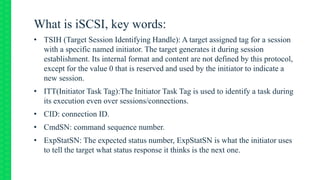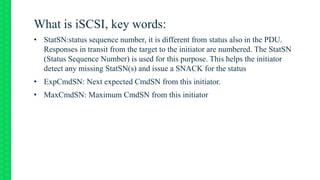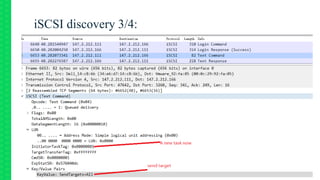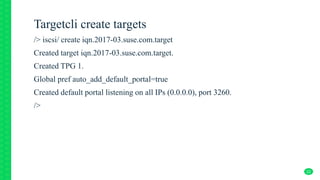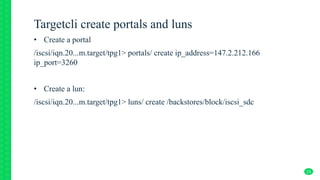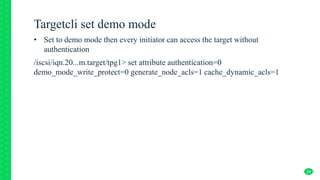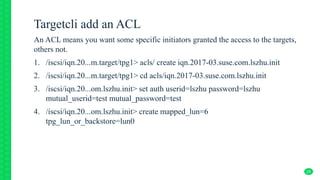iSCSI introduction and usage
- 1. iSCSI introduction and usage Zhu Lingshan lszhu@suse.com
- 2. What is SCSI Small Computer System Interface(SCSI) is a set of standards for physically connecting and transferring data between computers and peripheral devices. The SCSI standards define commands, protocols, electrical and optical interfaces. SCSI is most commonly used for hard disk drives and tape drives, but it can connect a wide range of other devices, including scanners and CD drives, although not all controllers can handle all devices. The SCSI standard defines command sets for specific peripheral device types; the presence of "unknown" as one of these types means that in theory it can be used as an interface to almost any device, but the standard is highly pragmatic and addressed toward commercial requirements.
- 3. What is SCSI SCSI Initiator: An endpoint that initiates a SCSI session, that is, sends a SCSI command. SCSI Target: Usually a disk or a storage array. SCSI LUN: SCSI Logical Unit Number, the °∞real storage°±, a SCSI target should have at least one LUN: LUN0. In SCSI terminology, communication takes place between an initiator and a target. The initiator sends a command to the LUN, which then responds. SCSI commands are sent in a Command Descriptor Block (CDB).
- 4. What is SCSI Lsscsi shows [Host:Bus:Target:LUN], device type, vendor, etc lsscsi shows SATA devices, Because SATA uses SCSI transport layer.
- 5. What is SCSI
- 7. What is iSCSI Carry SCSI CBD in iSCSI PDU, benefit from IP networks. Key words in iSCSI: ? ISID: The initiator part of the Session Identifier. It is explicitly specified by the initiator during Login. ? I_T nexus: According to [SAM2], the I_T nexus is a relationship between a SCSI Initiator Port and a SCSI Target Port. ? SSID (Session ID): A session between an iSCSI initiator and an iSCSI target is defined by a session ID that is a tuple composed of an initiator part (ISID) and a target part (Target Portal Group Tag). The ISID is explicitly specified by the initiator at session establishment. The Target Portal Group Tag is implied by the initiator through the selection of the TCP endpoint at connection establishment.
- 8. What is iSCSI, key words: ? TSIH (Target Session Identifying Handle): A target assigned tag for a session with a specific named initiator. The target generates it during session establishment. Its internal format and content are not defined by this protocol, except for the value 0 that is reserved and used by the initiator to indicate a new session. ? ITT(Initiator Task Tag):The Initiator Task Tag is used to identify a task during its execution even over sessions/connections. ? CID: connection ID. ? CmdSN: command sequence number. ? ExpStatSN: The expected status number, ExpStatSN is what the initiator uses to tell the target what status response it thinks is the next one.
- 9. What is iSCSI, key words: ? StatSN:status sequence number, it is different from status also in the PDU. Responses in transit from the target to the initiator are numbered. The StatSN (Status Sequence Number) is used for this purpose. This helps the initiator detect any missing StatSN(s) and issue a SNACK for the status ? ExpCmdSN: Next expected CmdSN from this initiator. ? MaxCmdSN: Maximum CmdSN from this initiator
- 14. How iSCSI carry SCSI commands 14
- 15. Yast iSCSI target usage: discovery
- 16. Yast iSCSI target usage: add a target
- 17. Yast iSCSI target usage: add an initiaitor
- 18. Yast iSCSI target usage: login authentication
- 19. Yast iSCSI target usage: LUNs mapping
- 21. Targetcli create backend storage ? Create a backend storage with a existed file: backstores/fileio create name=iscsi_file file_or_dev=/home/lszhu/target.raw ? Create a backend storage with a file not existed, while you want to create the file at the same time. backstores/fileio create name=iscsi_file file_or_dev=/home/lszhu/target.raw size=100M ? Create a backend storage with a block device backstores/block/ create name=iscsi_sbc dev=/dev/sdc 21
- 22. Targetcli create targets /> iscsi/ create iqn.2017-03.suse.com.target Created target iqn.2017-03.suse.com.target. Created TPG 1. Global pref auto_add_default_portal=true Created default portal listening on all IPs (0.0.0.0), port 3260. /> 22
- 23. Targetcli create portals and luns ? Create a portal /iscsi/iqn.20...m.target/tpg1> portals/ create ip_address=147.2.212.166 ip_port=3260 ? Create a lun: /iscsi/iqn.20...m.target/tpg1> luns/ create /backstores/block/iscsi_sdc 23
- 24. Targetcli set demo mode ? Set to demo mode then every initiator can access the target without authentication /iscsi/iqn.20...m.target/tpg1> set attribute authentication=0 demo_mode_write_protect=0 generate_node_acls=1 cache_dynamic_acls=1 24
- 25. Targetcli add an ACL An ACL means you want some specific initiators granted the access to the targets, others not. 1. /iscsi/iqn.20...m.target/tpg1> acls/ create iqn.2017-03.suse.com.lszhu.init 2. /iscsi/iqn.20...m.target/tpg1> cd acls/iqn.2017-03.suse.com.lszhu.init 3. /iscsi/iqn.20...om.lszhu.init> set auth userid=lszhu password=lszhu mutual_userid=test mutual_password=test 4. /iscsi/iqn.20...om.lszhu.init> create mapped_lun=6 tpg_lun_or_backstore=lun0 25
- 26. Q&A
- 27. Thanks

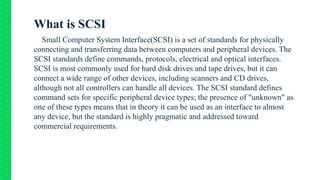
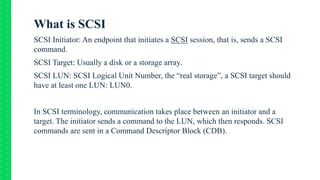
![What is SCSI
Lsscsi shows [Host:Bus:Target:LUN], device type,
vendor, etc
lsscsi shows SATA devices, Because SATA uses SCSI
transport layer.](https://image.slidesharecdn.com/iscsiintro1-170317091635/85/iSCSI-introduction-and-usage-4-320.jpg)


![What is iSCSI
Carry SCSI CBD in iSCSI PDU, benefit from IP networks.
Key words in iSCSI:
? ISID: The initiator part of the Session Identifier. It is explicitly specified by
the initiator during Login.
? I_T nexus: According to [SAM2], the I_T nexus is a relationship between a
SCSI Initiator Port and a SCSI Target Port.
? SSID (Session ID): A session between an iSCSI initiator and an iSCSI target
is defined by a session ID that is a tuple composed of an initiator part (ISID)
and a target part (Target Portal Group Tag). The ISID is explicitly specified by
the initiator at session establishment. The Target Portal Group Tag is implied
by the initiator through the selection of the TCP endpoint at connection
establishment.](https://image.slidesharecdn.com/iscsiintro1-170317091635/85/iSCSI-introduction-and-usage-7-320.jpg)
